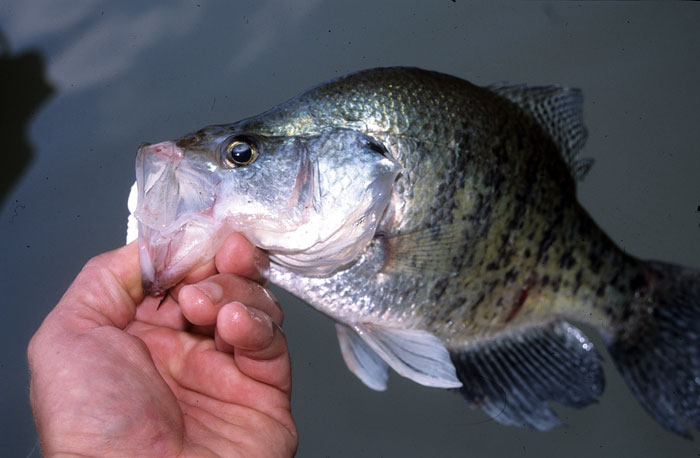
Author: Lee McClellan–
Kentucky Dept. of Fish and Wildlife Resources News
Kentucky Afield Outdoors:
Late winter crappie fishing is upon us
Feb. 3, 2011 Contact: Lee McClellan
FOR IMMEDIATE RELEASE 1-800-858-1549, ext. 4443
FRANKFORT, Ky. – With the winds seemingly coming straight from the North Pole and most of the country crushed under the weight of a monster blizzard with a side order of ice, thinking about crappie fishing seems silly. Those intrepid enough to find the right conditions can catch crappie in the near future, even after the lashing nature’s given Kentucky this winter.

“I know a guy who is catching crappie right now in a spot in Little River of Lake Barkley that is just a little warmer than the rest of the lake,” said Ryan Oster, federal aid coordinator for the Kentucky Department of Fish and Wildlife Resources. “He’s throwing jigs and catching both white and black crappie.”
The majority of crappie in Lake Barkley or Kentucky Lake lie hunkered down in fairly deep water at this time, skulking along the main lake ledges until the water warms. Anglers often struggle to find those isolated patches of warm water holding crappie in February.
“Things may start on Lake Barkley sooner than Kentucky Lake,” Oster, who formerly served as assistant western fishery district biologist, said. “It is a shallower lake and warms up just a little earlier. A warm rain will bring those crappie up shallower on both lakes.”
Black crappie move to the bank earlier than white crappie after warm rains or during a late winter warming trend. It is difficult to imagine a warming trend with the winter we’ve had, but one will come sometime in late February or early March.
“The black crappie will move to the banks as early as February with the right conditions and the white crappie will follow a little later,” Oster said. “Cast the banks with a 1/16-ounce feather or tube jigs in white, chartreuse or lime green. You want a slow fall for your jigs at that time of year.”
Although Kentucky Lake and Lake Barkley hold national reputations for crappie fishing, rivers may hold the key to the best late winter crappie fishing in the state. The Ohio River and the Kentucky River both should produce surprisingly good crappie fishing in the next few weeks.
“The Ohio River is looking pretty good for crappie,” said Jeff Crosby, central fishery district biologist for Kentucky Fish and Wildlife. “A good warm rain will pull the crappie into the embayments and tributaries.”
Anglers should target brushy areas in the embayments and backwaters on the Ohio River with live minnows for late winter crappie. White or chartreuse 2- to 3-inch curly-tailed grubs rigged on 1/8-ounce leadheads also work well. Use a light wire hook that will bend enough to free your grub from the brush if it gets hung. Bend the hook back after retrieval and make another cast. If the river’s current pulls the grub off the brush, switch to a ¼-ounce leadhead.
The waters of the Kentucky River bring good late winter crappie fishing from Irvine all the way downstream to Carrolton. The river is on a tremendous upswing for crappie with good numbers of fish in the 9- to 12-inch range with much larger fish present. White crappie dominate the population in the Kentucky River with sporadic numbers of black crappie in the mix.
“Starting in late February and the beginning of March, the longer days will start to warm the water,” Crosby explained. “When we get a warmer rain, it will pull crappie into the mouths of the tributaries on the Kentucky River. Those tributaries that have brush are all the better.”
Just like the Ohio River, white or chartreuse grubs rigged on a 1/8-ounce leadhead worked in the brush and laydown trees produce Kentucky River crappie. A live minnow wiggling under a bobber drifted beside the brush should get crushed if the area holds any fish.
A tributary mouth that is slightly warmer than the main river makes for the best fishing. A tributary discharging water that is as cold or colder than the main river channel won’t hold crappie. Keep searching until you find warmer water when late winter crappie fishing on the Kentucky River.
Rocky banks holding broken tree branches or laydown trees also hold crappie in late February or March, especially on sunny days. Rocks serve as heat sinks as the rays of the sun transmit warmth to them. This warms the water around the rocks and the crappie will congregate near any woody cover in these areas. You may also pick off a Kentucky spotted or smallmouth bass on rocky outside bends of the Kentucky River.
Also, keep in mind that your fishing license expires Feb. 28. Don’t forget to get your new fishing license before you head out on the water.
Although it doesn’t seem possible right now, the weather will break in a few weeks. A warm rain or a few days of sunshine are all that is needed for the crappie to start biting.
Author Lee McClellan is an award-winning associate editor for Kentucky Afield magazine, the official publication of the Kentucky Department of Fish and Wildlife Resources. He is a life-long hunter and angler, with a passion for smallmouth bass fishing.
(Editors: Please email Lee.McClellan@ky.gov for photos.)
-30-
The Kentucky Department of Fish and Wildlife Resources manages, regulates, enforces and promotes responsible use of all fish and wildlife species, their habitats, public wildlife areas and waterways for the benefit of those resources and for public enjoyment. Kentucky Fish and Wildlife is an agency of the Tourism, Arts and Heritage Cabinet. For more information on the department, visit our website at fw.ky.gov.



Be the first to comment